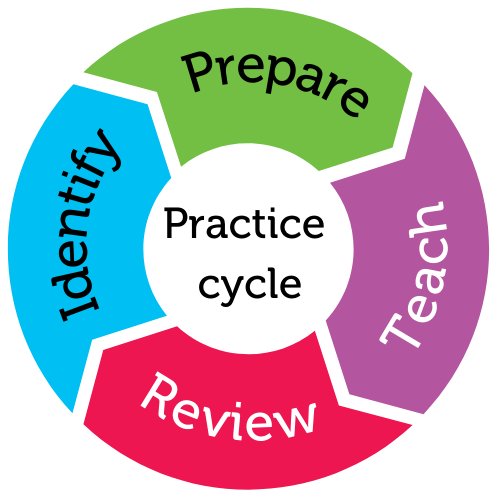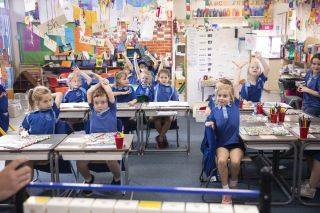
For student year
Helps students to
- learn new concepts
- follow lengthy instructions
Helps teachers to
- explain difficult concepts
- communicate effectively
Summary
Because of differences in how language is processed and understood, some students may need support in following and remembering instructions, discussions and information that is only presented verbally.
You can support students to access and understand information by consistently supplementing oral communication (talking) with visual and/or written instructions and materials. Visual supports include pictures, such as stick-figure drawings, photographs or cartoons, and words, i.e., written materials.
Visual supports are useful for all students, including those on the autism spectrum, and…
- make abstract concepts concrete
- increase understanding
- makes resources accessible for everyone
- are ‘intransient’ – students can refer back to the support
How the practice works
Watch this video to learn more about how to use visual supports in your classroom.
Duration: 3:11
Australian Professional Standards for Teachers related to this practice
1.6 - strategies to support the full participation of students with disability
4.1 - support student participation
For further information, see Australian Professional Standards for Teachers AITSL page
Preparing to teach
How does it help?
Some students need the opportunity to see information in order to interpret its meaning. Teachers can capitalise on this strength in the classroom by using visual/written strategies and resources to support spoken instructions and explanations. Visual supports are both simple to use and often very effective.
When information is presented verbally, the words are only available for a brief moment. Information presented visually, using symbols, pictures or words, remains in place for as long as the student needs it. This gives students time to understand it and to refer back to the material when needed.
Visual cues such as icons to indicate activities for writing, reading, group work etc can also help students to easily identify the tasks.
Types of visual and/or written materials that can be used in classrooms include:
- written lesson plans
- visual schedules
- checklists
- posters
- charts
- graphic organisers
Assessing and/or consulting with specialists about the student’s comprehension skills will help you to determine which information should be presented visually for the learner, e.g., an academic concept or instructions.
Use this information to help you to select the best forms of representation: objects, photographs, drawings or words/written material or a combination of these formats.
It works better if visual supports are…
- age and ability appropriate
- used in times of transition, change, stress and anxiety
- used consistently so that individuals attach meaning to them
- move with the student across settings, e.g., to other classes or visual supports are located across settings
- linked specifically to the topics
- offered to all students
It doesn’t work if visual supports are…
- not appropriate to the capacities of the learner or unnecessarily complex
- only used with learners on the spectrum
In the classroom
How do I do it?
- Look at the lesson plans and see where visual supports can be created to support your learners
- Gather and arrange all visual supports prior to activity/event eg. curriculum supports are paired with academic materials
- Teach using the visual support
- Show the learner the visual support, scaffold and team them how to use it
- Refer to the visual supports and cues
- Check for comprehension and understanding
- Reflect on whether the visuals are working and meeting the intended goal and aim of this practice
How will I know if it’s working?
- Student comprehension increases; they understand information and instructions better.
- Students complete more tasks independently and adapt more readily to change.
- Students have decreased levels of frustration and anxiety in relation to task completion.
Practice toolkit
Practice implementation planner template
We know it's not always easy to keep track of what's working and what isn't. So, we've created this template for you to record and reflect on what you're doing to create more inclusive classrooms. The implementation planner contains:
- guidance around goal setting
- a reflection section (what worked, didn’t work, what to change, and next steps)
- prompting questions.
Implementation planner with examples
Set your professional learning goal for:
Use visual supports to increase understanding
Benefits of goal setting
Setting, working towards, and reflecting on goals helps you grow professionally and improve your practice. You can access AITSL learning resources for teachers to learn more about:How to set goals
The Australian Institute for Teaching and School Leadership recommends using the SMART matrix to frame your goal setting.SMART goals refers to goals that are:
- Specific
- Measurable
- Achievable
- Relevant
- Time-phased
Resources
Use visual supports to increase understanding - Practice Brief
Related Practices

Use visual schedules
TEACHING PRACTICE
For student years
Helps students to
- transition smoothly
- understand expectations
- learn new concepts

Use visual self-management tools
TEACHING PRACTICE
For student years
Helps students to
- build greater independence
- maintain on-task behaviour
This practice is from the core research project
Learning Cycle

